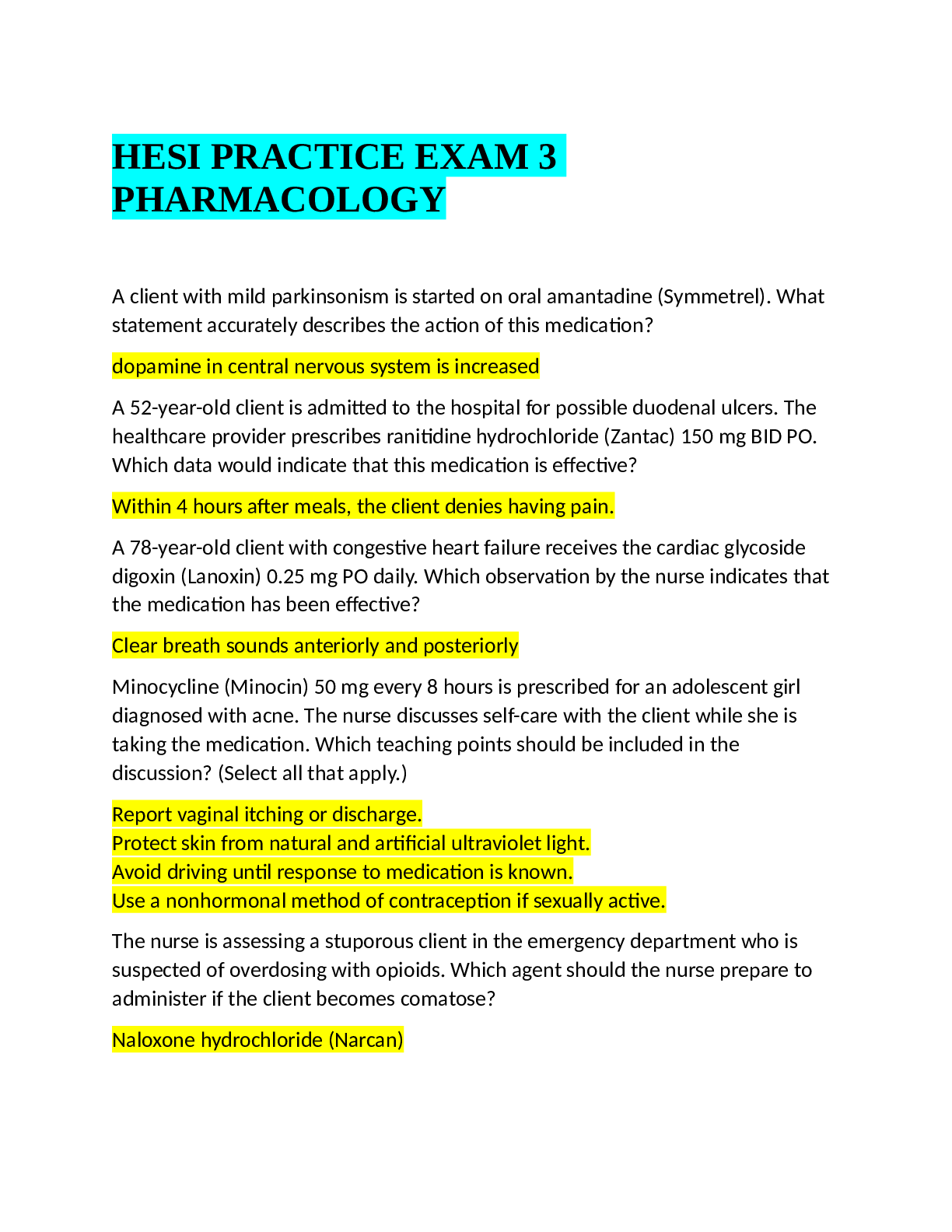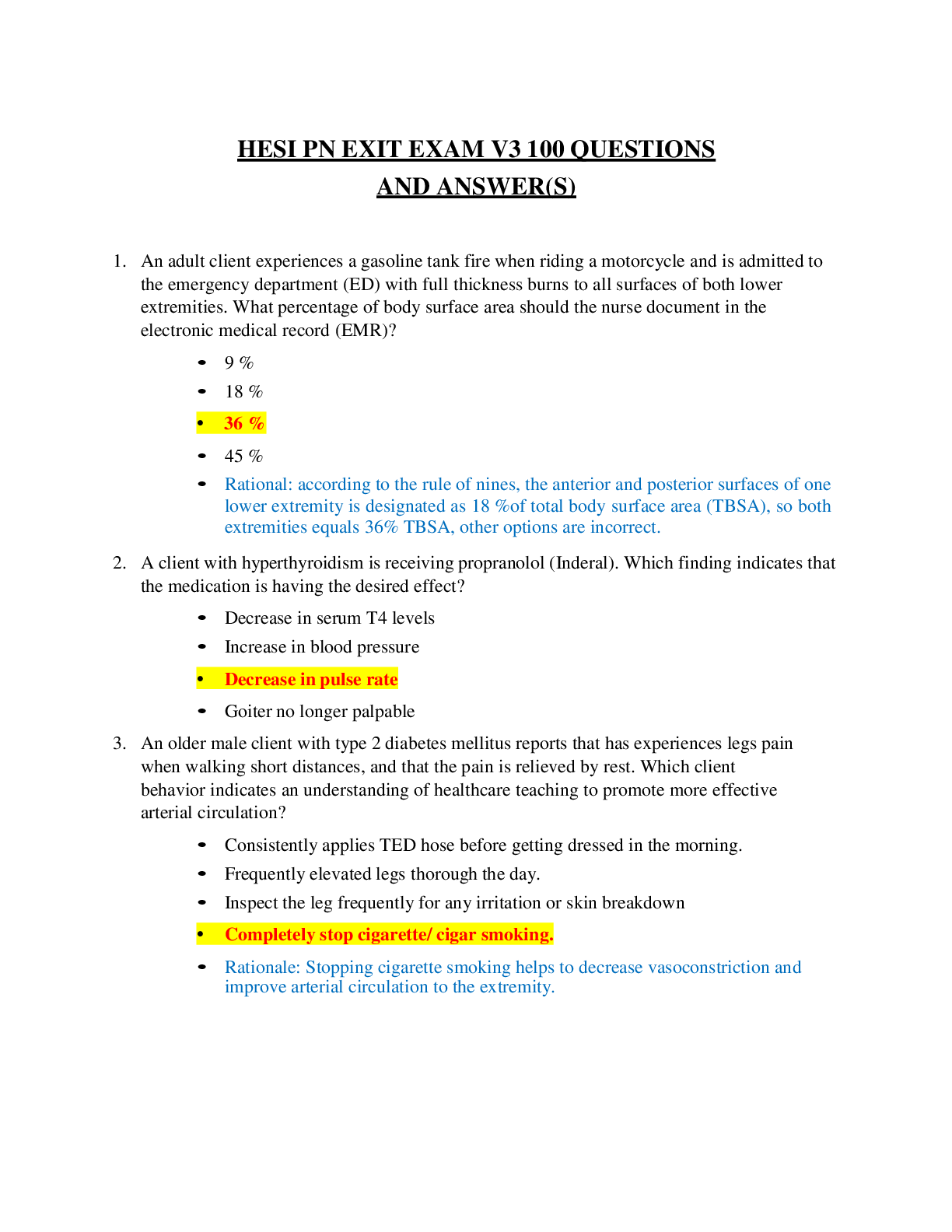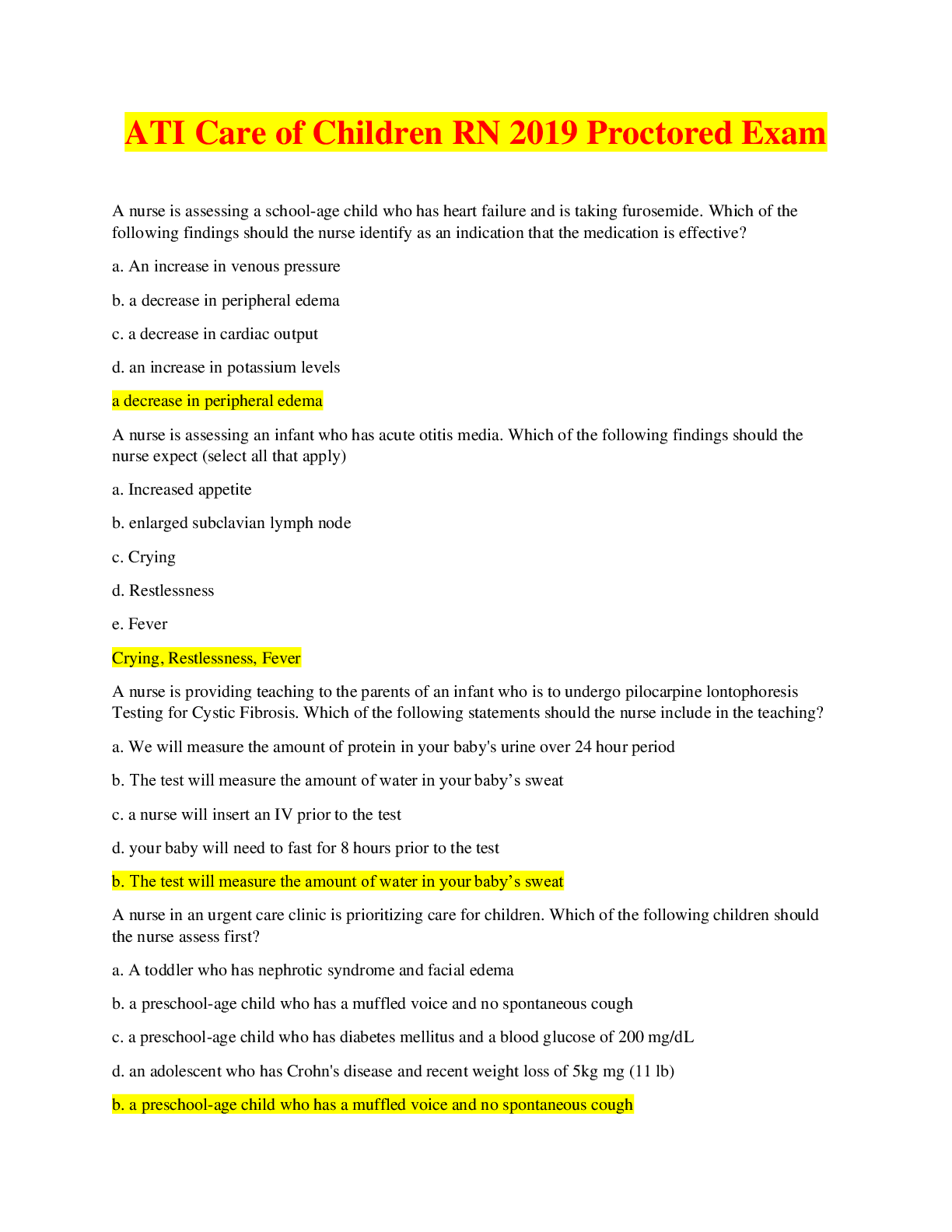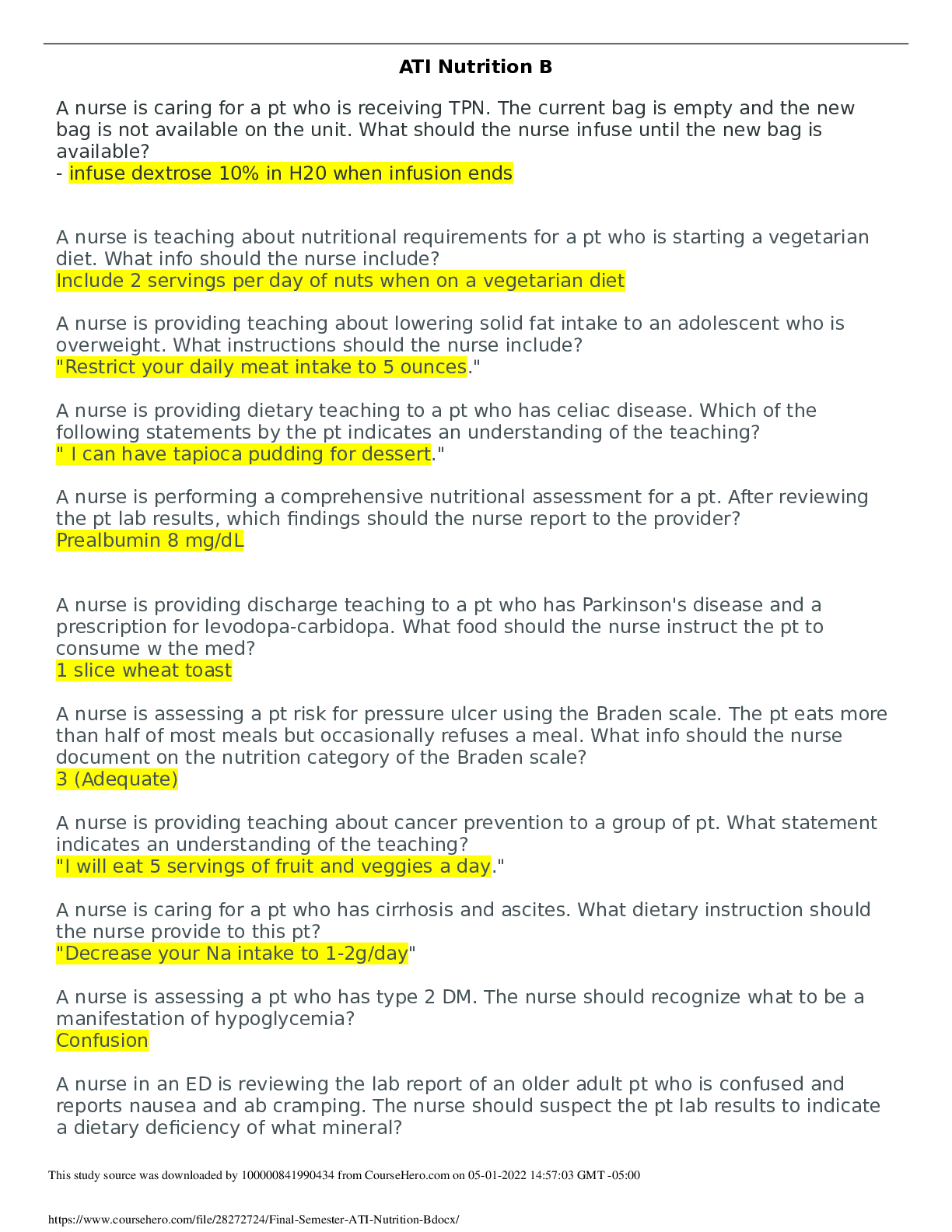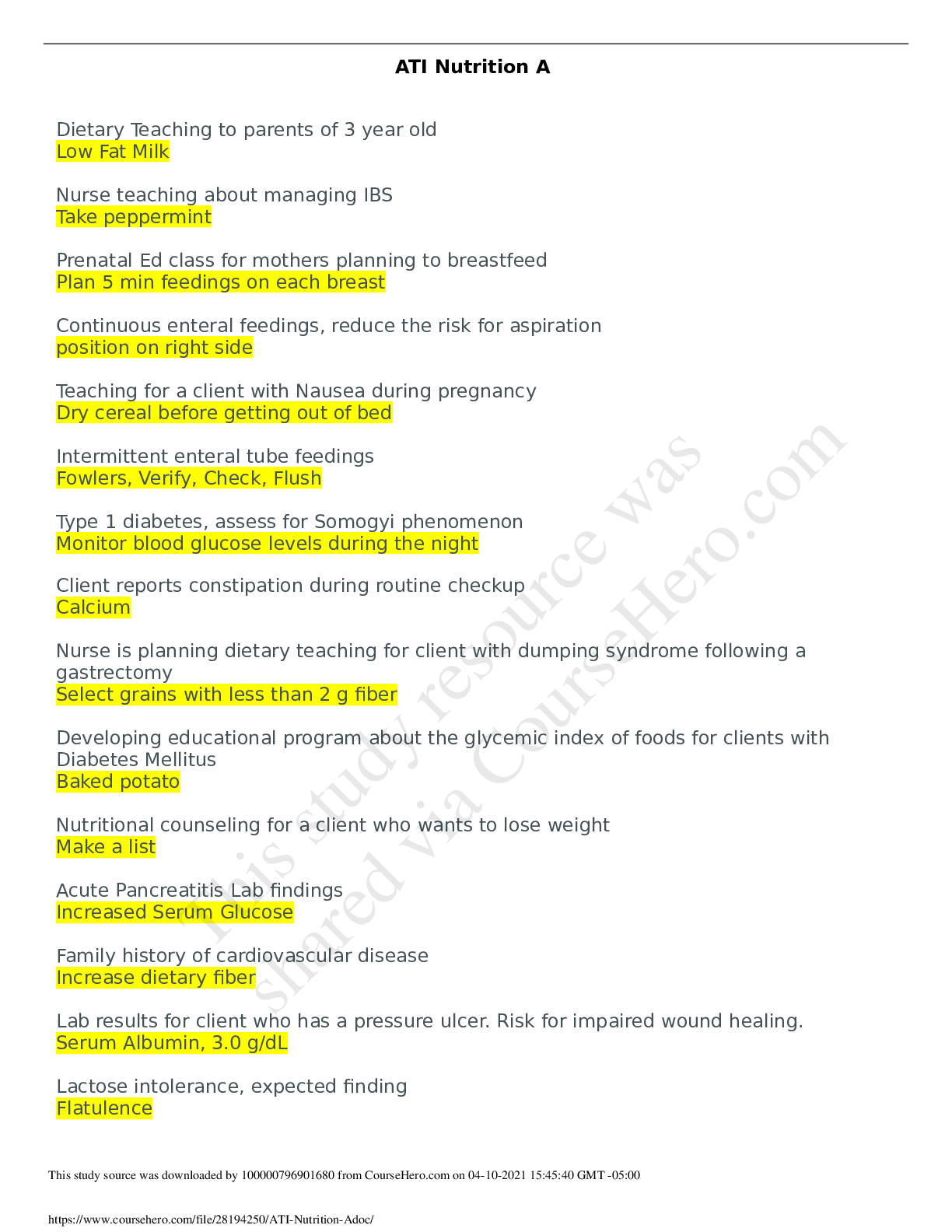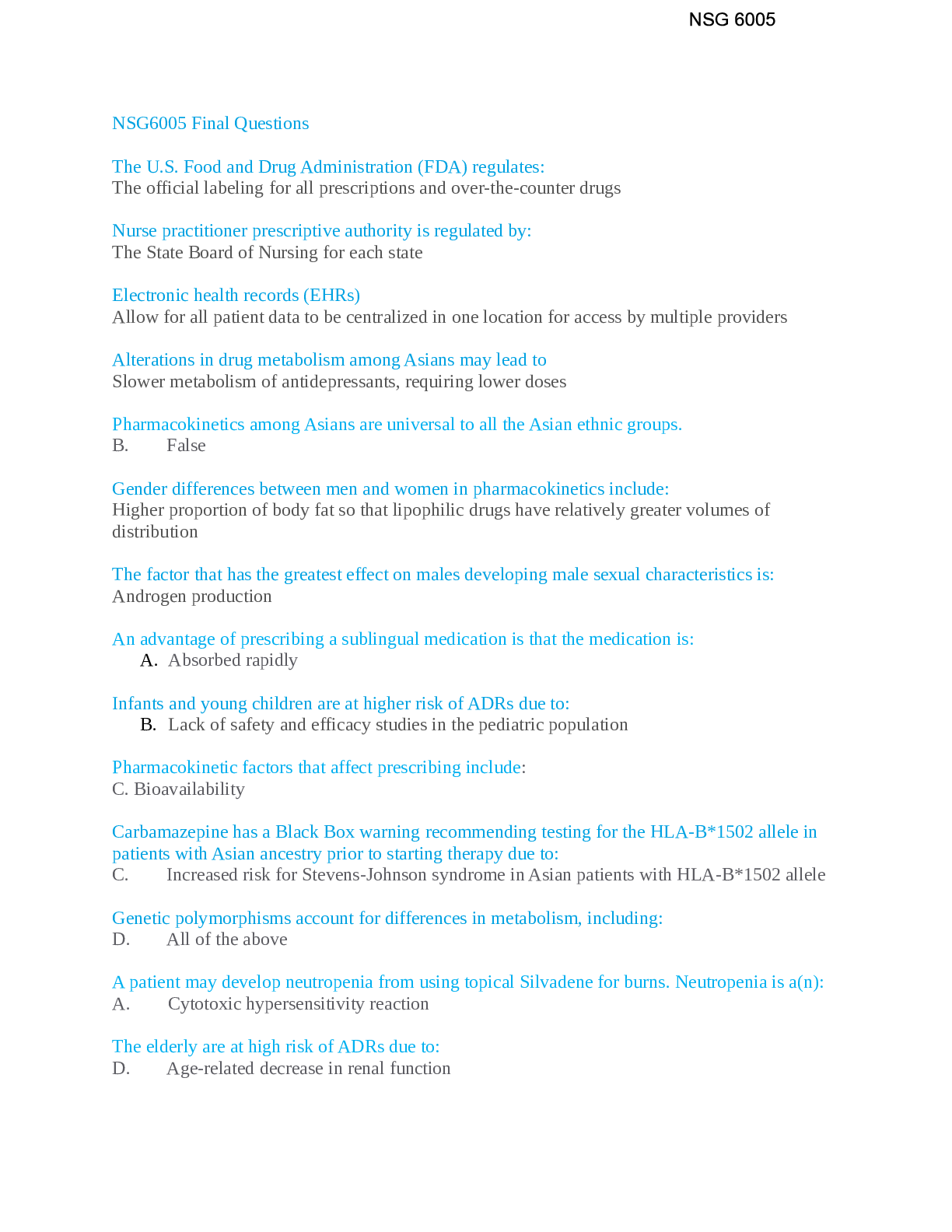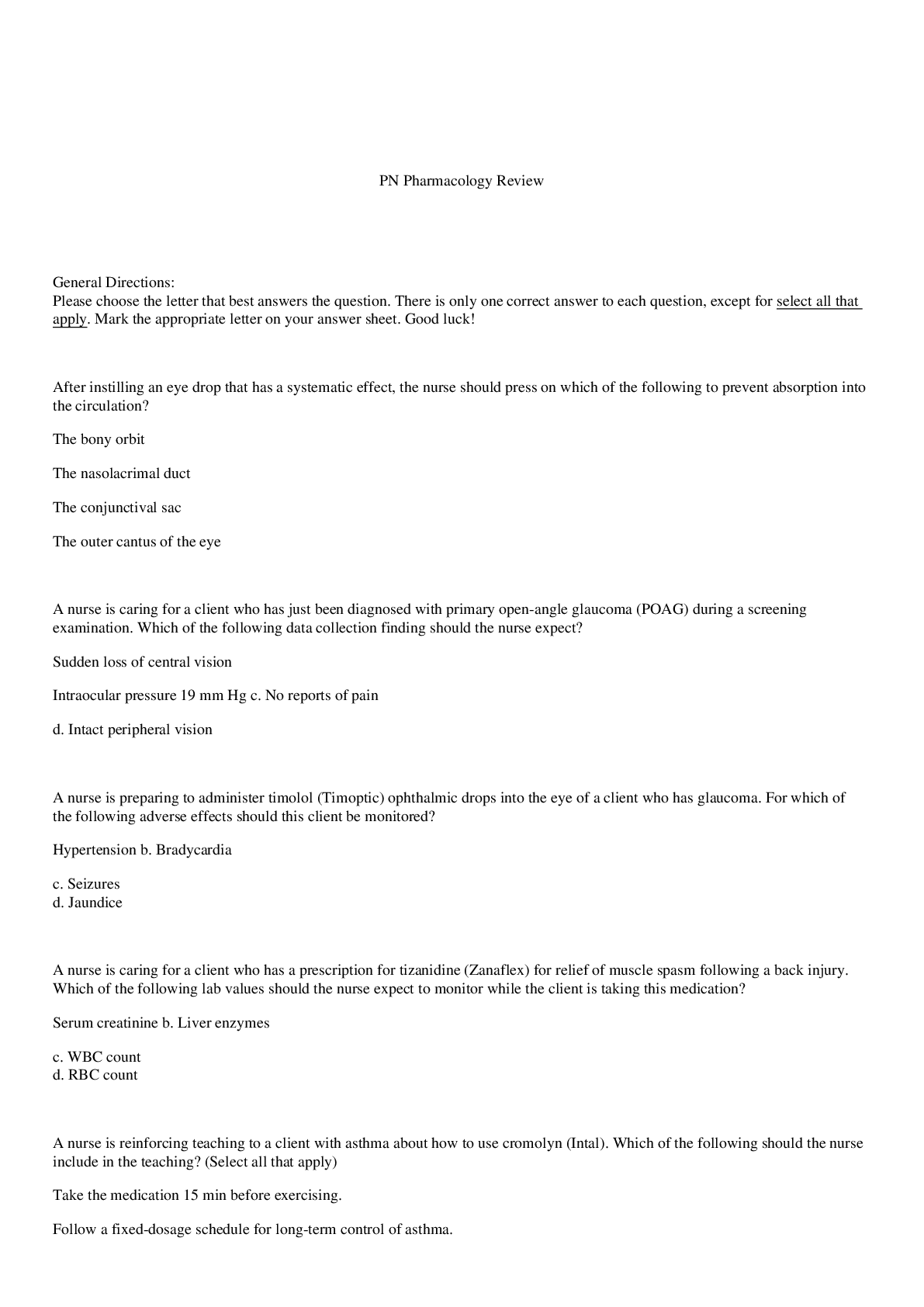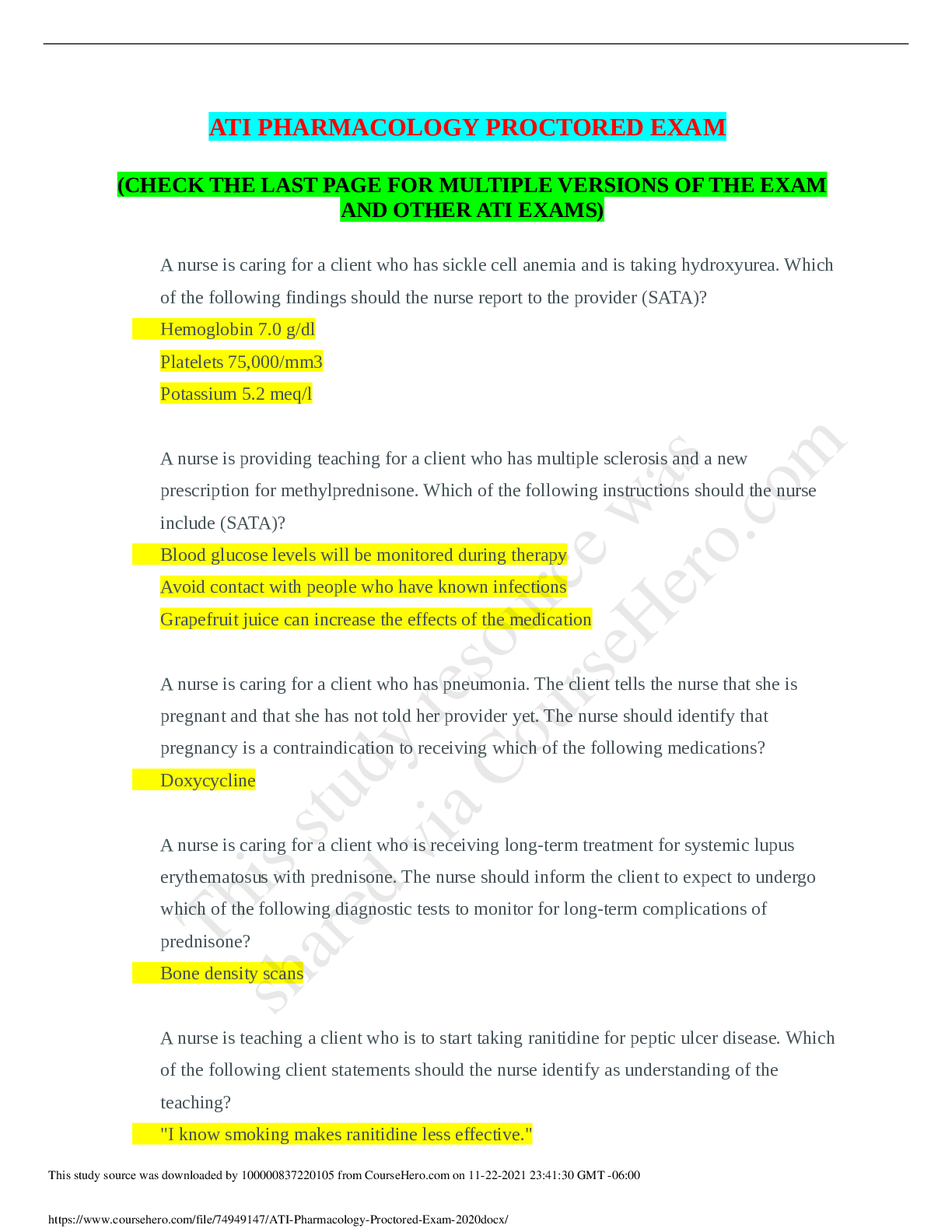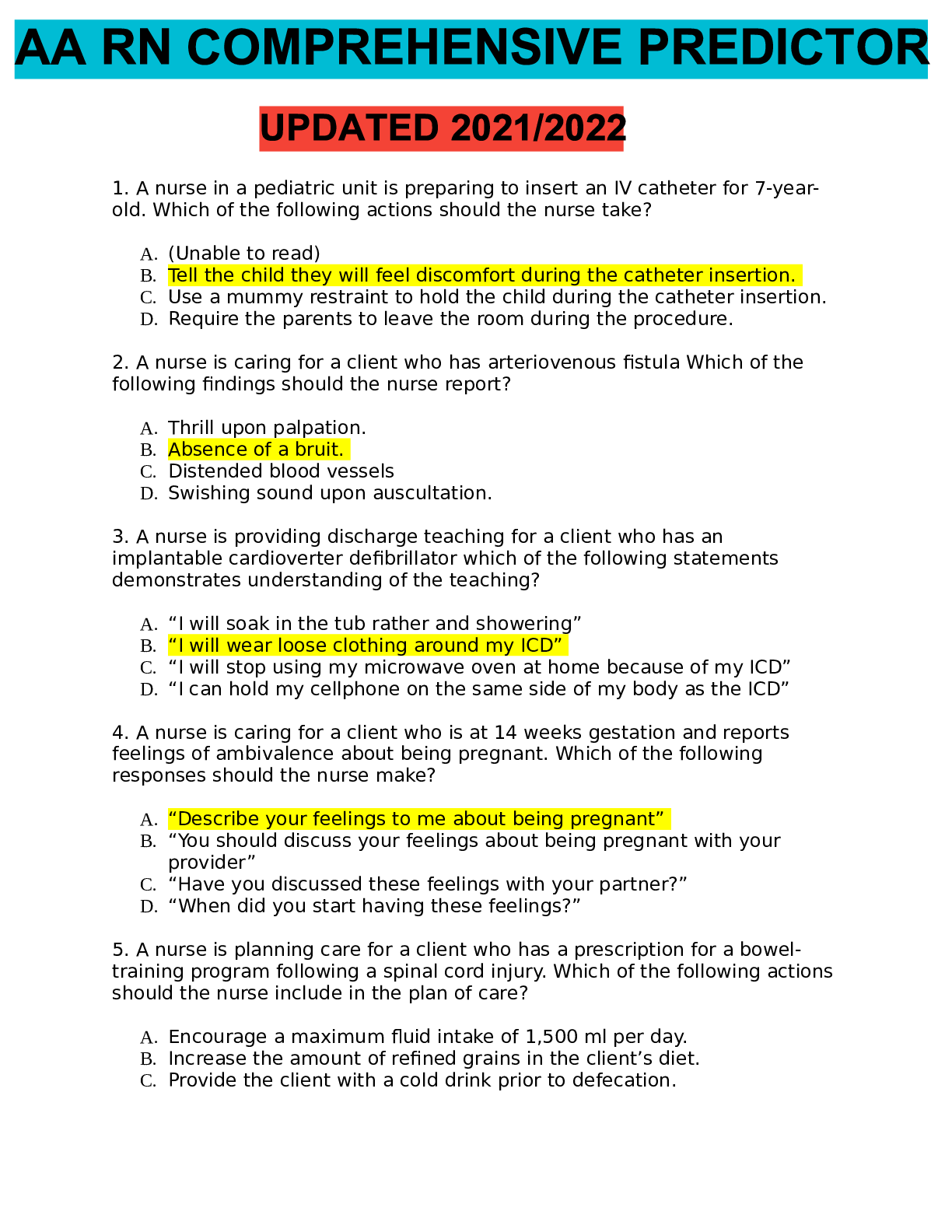*NURSING > EXAM > PATHO 2410 Nutrition/Elimination/Sexuality Test Bank Questions And Answers( Complete Solution Rated (All)
PATHO 2410 Nutrition/Elimination/Sexuality Test Bank Questions And Answers( Complete Solution Rated A)
Document Content and Description Below
PATHO 2410 Nutrition/Elimination & Sexuality (CP #4) Test Bank Chapter 17 1. Which of the following cells in the gastric mucosa produce intrinsic factor and hydrochloric acid? a. Parietal cells ... b. Chief cells c. Mucous cells d. Gastrin cells 2. Which of the following is the primary site for absorption of nutrients? a. Stomach b. Duodenum c. Ileum d. Ascending colon 3. When highly acidic chyme enters the duodenum, which hormone stimulates the release of pancreatic secretions that contains very high bicarbonate ion content? a. Gastrin b. Secretin c. Cholecystokinin d. Histamine 4. Which of the following breaks protein down into peptides? a. Amylase b. Peptidase c. Lactase d. Trypsin 5. In which structure is oxygenated blood (arterial) mixed with unoxygenated blood (venous) so as to support the functions of the structure? a. Pancreas b. Liver c. Small intestine d. Spleen 6. Which of the following stimulates increased peristalsis and secretions in the digestive tract? a. Sympathetic nervous system b. Vagus nerve c. Increased saliva d. Absence of food in the system 7. Which of the following is contained in pancreatic exocrine secretions? a. Bicarbonate ion b. Hydrochloric acid c. Activated digestive enzymes d. Insulin 8. The presence of food in the intestine stimulates intestinal activity but inhibits gastric activity through the: a. Defecation reflex b. Enterogastric reflex c. Vomiting reflex d. Autodigestive reflex 9. Which of the following processes is likely to occur in the body immediately after a meal? a. Lipolysis b. Ketogenesis c. Gluconeogenesis d. Glycogenesis 10. What does the term gluconeogenesis refer to? a. Breakdown of glycogen to produce glucose b. Conversion of excess glucose into glycogen for storage c. Formation of glucose from protein and fat d. Breakdown of glucose into carbon dioxide and water 11. Normally, proteins or amino acids are required to produce all of the following EXCEPT: a. Peptide hormones b. Clotting factors and antibodies c. Cellular energy d. Hemoglobin 12. Which of the following statements applies to bile salts? a. The give feces the characteristic brown color b. They are enzymes used to break down fats into free fatty acids c. They emulsify lipids and lipid-soluble vitamins d. They are excreted in the feces 13. The visceral peritoneum: a. Lines the abdominal wall b. Hangs from the stomach over the lops of small intestine c. Contains many pain receptors d. Form the outer covering of the stomach 14. The early stage of vomiting causes: a. Metabolic alkalosis b. Metabolic acidosis c. Increased respirations d. Increased excretion of hydrogen ions 15. Yellow or greenish stained vomitus usually indicated the presence of: a. Bile b. Blood c. Protein d. Bacteria 16. Small, hidden amounts of blood in stool are referred to as: a. Melena b. Occult blood c. Frank blood d. Hematemesis 17. Severe vomiting can leas to metabolic acidosis because of increased: a. Ketones produces b. CO2 retained in the lungs and kidneys c. Hypovolemia and lactic acid production d. Metabolic rate 18. Which of the following applies to the act of swallowing? a. It requires coordination of cranial nerves V, IX, X, and XII. b. It is entirely voluntary c. It is controlled by a center in the hypothalamus d. It does not affect respiration 19. What does the defecation reflex require? a. Stimulation by the sympathetic nervous system b. Contraction of the internal anal sphincter c. Coordination through the sacral spinal cord d. Voluntary relaxation of pelvic muscles 20. What is the definition of dysphagia? a. A herniation of the gastric mucosa through a segment of weakened muscle b. Recurrent reflux of chyme into the esophagus c. Absence of a connection of the esophagus to the stomach d. Difficulty swallowing 21. What does congenital esophageal atresia cause? a. Direct passage of saliva and food from the mouth into the trachea b. Repeated reflux of gastric secretions into the esophagus c. No fluid or food entering the stomach d. Gastric distention and cramps 22. Which of the following applies to cleft palate? a. The mandibular processes do not fuse b. The hard and soft palates do not fuse during the first trimester of pregnancy c. Exposure to environmental factors in the last trimester causes the defect d. Speech and eating are not affected 23. Oral candidiasis is considered to: a. Be a common bacterial infection in infants and young children b. Cause painful ulcerations in the mucosa and tongue c. Cause white patches in the mucosa that cannot be scraped off d. Be an opportunistic fungal infection of the mouth 24. Why does herpes simplex infection tend to recur? a. Active infection is usually asymptomatic b. The virus builds up a resistance c. The virus persists in latent form in sensory nerve genitalia d. The virus mutates; therefor, no effective immunity develops 25. What does the term periodontitis refer to? a. Erosion of the enamel tooth surface b. Bacterial damage to the teeth and surrounding alveolar bone c. Inflammation and infection of the gingivae d. Formation of calcified plaque on the tooth 26. What is/are common location(s) for oral cancer? a. Floor of the mouth or tongue borders b. Mucosa lining the cheeks c. Hard or soft palate d. Gingivae near the teeth 27. What is a common cause of hiatal hernia? a. An abnormally long esophagus b. Increased intra-abdominal pressure c. Stenosis of the hiatus in the diaphragm d. A small fundus in the stomach 28. What is a common sign of acute gastritis? a. Colicky right upper quadrant pain b. Vomiting and anorexia c. Projectile vomiting after eating d. Diarrhea with abdominal distention 29. What does the pathophysiology of chronic gastritis include? a. Atrophy of the gastric mucosa with decreased secretions b. Hyperchlrhydria and chronic peptic ulcers c. Frequent vomiting and diarrhea d. Episodes of acute inflammation and edema of the mucosa 30. What is a common cause of gastroenteritis due to Salmonella? a. Unrefrigerated custards or salad dressings b. Poorly canned foods c. Raw or undercooked poultry or eggs d. Contaminated water 31. Which of the following individuals is likely to develop acute gastritis? a. A long-term, heavy cigarette smoker b. Patient with arthritis taking enteric-coated aspirin on a daily basis c. A person with an autoimmune reaction in the gastric mucosa d. An individual with an allergy to shellfish 32. What does congenital pyloric stenosis involve? a. Absence of peristalsis in the lower section of the stomach b. Failure of an opening to develop between the stomach and duodenum c. Hypertrophy of smooth muscle in the pylorus d. Thickening of the gastric wall due to chronic inflammation 33. A patient with acquired pyloric stenosis would likely: a. Have an increase in appetite b. Have chronic diarrhea c. Develop severe colicky pains d. Vomit undigested food from previous meals 34. Prolonged or severe stress predisposes to peptic ulcer disease because: a. Of reduced blood flow to the gastric wall and mucous glands b. Of reduced bicarbonate content in bile and pancreatic secretions c. Stress increases the number of acid- and pepsinogen-secreting cells d. Increased epinephrine increases motility 35. The pathophysiology of peptic ulcer disease may involve any of the following EXCEPT: a. Decreased resistance of the mucosal barrier b. Increases stimulation of pepsin and acid secretions c. Infection by H. pylori d. Increases stimulation of mucus-producing glands 36. Which of the following would a perforated gastric ulcer likely cause? a. Severe anemia b. Chemical peritonitis c. Severe gastric hemorrhage d. Pyloric obstruction 37. What is frequently the first manifestation of stress ulcers? a. Abdominal discomfort between meals and at night b. Nausea and diarrhea c. Hematemesis d. Sharp colicky pain with food intake 38. What would be the result of chronic bleeding from gastric carcinoma? a. Occult blood in the stool and anemia b. Hematemesis and shock c. Abdominal pain and distention d. Red blood on the surface of stool 39. Following gastric resection, the onset of nausea, cramps, and dizziness immediately after meals indicates: a. A large volume of chyme has entered the intestines, causing distention b. Severe hypoglycemia has developed c. The pylorus is restricting the flow of chyme d. Bile and pancreatic secretions are irritating the small intestine 40. Bilirubin is a product of: a. Hemolysis of red blood cells (RBCs) and breakdown of hemoglobin b. Production of excess chyme and bile c. Mixing of undigested food and gastric secretions d. Accumulation of white blood cells (WBCs) due to infection 41. Why does mild hyperbilirubinemia occur in newborns? a. Blood incompatibility between mother and chils b. Damage to many erythrocytes during the birth process c. Poor circulation and albumin transport for bilirubin d. Immature liver cannot process bilirubin quickly enough 42. Predisposing factors to cholelithiasis include excessive: a. Bilirubin or cholesterol concentration in the bile b. Water content in the bile c. Bile salts in the bile d. Bicarbonate ions in the bile 43. What is the major effect when a gallstone obstructs the cystic duct? a. Intrahepatic jaundice b. Acute pancreatitis c. Severe colicky pain in upper right quadrant d. Inflammation an infection in the gallbladder 44. Obstruction of the biliary tract by gallstones is referred to as: a. Cholelithiasis b. Cholecystitis c. Cholangitis d. Choledocholithiasis 45. Which of the following applies to hepatitis A infection? a. It is also called serum hepatits b. It is transmitted by the fecal-oral route c. It contains a double strand of DNA d. It frequently leads to chronic hepatitis 46. What can be concluded if the hepatitis B antigen level remains high in the serum? a. Acute infection is present b. Chronic infection has developed c. Liver failure is in progress d. The usual prolonged recovery from and viral infection is occurring 47. What is the most common type of hepatitis transmitted by blood transfusion? a. HAV b. HBV c. HCV d. HEV 48. During the course of a hepatitis B infection, the onset of jaundice occurs in the: a. Incubation period b. Preicteric stage c. Icteric stage d. Posticteric stage 49. What is the likely effect of long-term exposure to a hepatotoxin? a. Full recovery to normal tissue after the toxin material has been removed b. Acute onset of vomiting, steatorrhea, and jaundice c. Continued mild inflammation of the liver without permanent damage d. Gradual irreversible damage to the liver and cirrhosis 50. What indicates the presence of third-stage alcohol hepatitis? a. Below normal blood levels of AST and ALT b. Upper left quadrant tenderness and dull pain c. A small, firm, nodular liver and portal hypertension d. Decreased production of blood clotting factors 51. A factor that may precipitate encephalopathy with cirrhosis is the elevated: a. Serum urea b. Conjugated bilirubin c. Serum ammonia d. Serum pH 52. In patients with cirrhosis, serum ammonia may increase when: a. Ingesting excessive lipids b. Bleeding occurs in the digestive tract c. An increase in unconjugated bilirubin occurs in the serum d. Less bile is produced 53. What is the primary cause of esophageal varices? a. Increased hydrostatic pressure in the veins b. Alcohol irritating the mucosa c. Failure to inactivate estrogen d. Poor nutritional status 54. What is the primary cause of increased bleeding tendencies associated with cirrhosis? a. Anemia and leucopenia b. Jaundice and pruritus c. Recurrent infections d. Deficit of vitamin K and prothrombin 55. Which factors contribute to ascites in patients with cirrhosis? a. Increased aldosterone and deficit of albumin b. Severe anemia and increases serum bilirubin c. Hypokalemia and increase ammonia d. Hyperproteinemia and persistent hypotension 56. Which of the following is a major cause of primary hepatocellular cancer? a. Metastatic tumors b. Acute hepatitis c. Long-term exposure to certain chemicals d. Chronic cholelithiasis 57. What causes massive inflammation and necrosis in acute pancreatitis? a. Formation of multiple thrombi an ischemia b. Infection by intestinal microbes c. Immune complex reaction d. Autodigestion of tissue by pancreatic enzymes 58. How does chemical peritonitis and shock frequently result from acute pancreatitis? a. Inflammation and increased vascular permeability of the peritoneum affect fluid balance b. Erosion in the intestinal wall causes release of bacteria c. Fat necrosis and hypocalcemia develop d. Secretions from the pancreas and intestine become more acidic 59. Malnutrition may develop in children with celiac disease because of: a. Damage to the intestinal villi b. Obstrution in the pancreatic ducts c. Acidosis, preventing activation of digestive enzymes d. Insufficient bile for absorption 60. Which of the following best describes steatorrhea? a. A light gray-colored stool b. A tarry black stool c. Bulky, fatty, foul-smelling stools d. Watery stools with mucus and blood 61. What is the dietary requirement for a child with celiac disease? a. Low sodium, high fat b. High carbohydrate, low protein c. High calorie with vitamin supplements d. Gluten-free 62. What are the typical changes occurring with Crohn’s disease? a. Degeneration and flattening of the villi in the small intestine b. Multiple herniations of the mucosa through weak areas of the muscularis c. A continuous area of mucosal inflammation and ulceration in the rectum and colon d. Inflamed areas of the wall of the ileum alternating with thick fibrotic or normal areas 63. Stools that are more liquid and contain mucus and frank blood are typical of: a. Diverticulitis b. Ulcerative colitis c. Chron’s disease d. Celiac disease 64. How may a fistula form with Crohn’s disease? a. Lack of peristalsis, leading to dilated areas of intestine b. Fibrosis and thickening of the wall, causing obstruction c. Erosion of the mucosa, causing bleeding d. Recurrent inflammation, necrosis, and fibrosis, forming a connection between intestinal loops 65. How does iron deficiency anemia frequently develop with ulcerative colitis? a. Loss of surface area for absorption in the ileum b. Bone marrow depression by toxic wastes c. Chronic blood loss in stools d. Insufficient hydrochloric acid for iron absoption 66. What is the cause of inflammatory bowel disease? a. Physical and emotional stress b. An autoimmune reaction c. A combination of recessive genes d. Idiopathic 67. What pain is typical of diverticulitis? a. Lower left quadrant b. Lower right quadrant c. Sharp, colicky, periumbilical d. Lower abdominal pain, radiating into the groin 68. What usually initiates acute appendicitis? a. Infection in the appendix b. An episode of severe diarrhea c. Obstruction of the lumen of the appendix d. Eating a low-fiber diet 69. With acute appendicitis, localized pain and tenderness in the lower right quadrant results from: a. Increased peristalsis in the adjacent colon b. Inflammation and stretching of the appendiceal wall c. Increased gas and fluid inside the appendix d. Local inflammation of the parietal peritoneum 70. How does localized peritonitis develop from acute appendicitis before rupture? a. The omentum walls off the inflamed area b. Intestinal bacteria escape through the necrotic appendiceal wall c. The obstructing object inside the appendix causes edema d. Bacteria escape into the circulating blood 71. What is a typical early sign of cancer in the ascending colon? a. Change in shape of the stool b. Incomplete emptying c. Mild but persistent pain in the lower left quadrant d. Occult blood in the stool 72. To which site does colon cancer usually first metastasize? a. Lungs b. Stomach c. Liver d. Spleen 73. How does a volvulus cause localized gangrene in the intestine? a. Hypotension and shock cause ischemia b. The mesenteric arteries are compressed in the twisted section of intestine c. A section of the intestine herniates between the muscles of the abdominal wall d. The distention of the intestinal wall causes increased permeability of the tissue 74. Which of the following is a typical indicator of an intestinal obstruction caused by paralytic ileus? a. Excessive audible bowel sounds b. Intermittent colicky pain c. Severe steady abdominal pain d. Visible peristalsis 75. A congenital condition in which parasympathetic innervation is missing from a section of the colon, impairing motility is referred to as: a. Diverticulitis b. Chron’s disease c. Irritable bowel syndrome (IBS) d. Hirschsprung’s disease 76. What causes hypovolemic shock to develop with intestinal obstruction? a. Continued vomiting and fluid shift into the intestine b. Hemorrhage into the intestine c. Rupture of the intestinal wall d. Repeated bouts of severe diarrhea 77. What causes the characteristic rigid abdomen found in the patient with peritonitis? a. Increased fluid and gas, causing abdominal distention b. Inflammation of the peritoneum and organs, causing a firm mass in the abdomen c. Inflamed peritoneum, resulting in reflex abdominal muscle spasm d. Voluntary contraction of the abdominal muscles as a protective mechanism 78. What would be the likely outcome from chemical peritonitis related to a perforated gallbladder? a. Leakage of intestinal bacteria into blood and the peritoneal cavity b. Massive hemorrhage and shock c. Breakdown of the gallstones d. Increasing peristalsis with intermittent painful spasms 79. How does pelvic inflammatory disease frequently lead to bacterial peritonitis? a. Chemical irritation by excessive ovarian and uterine secretions causes inflammation b. Ulceration and perforation of the uterus allow the bacteria to spread c. Infection spreads through the fallopian tubes directly into the peritoneal cavity d. Gangrene in the uterine wall spreads through into the pelvic cavity 80. Choose the significant change in arterial blood gases expected with prolonged severe vomiting: a. Increased bicarbonate ion, increased PCO2, serum pH 7.4 b. Decreased bicarbonate ion, decreased PCO2, serum pH 7.35 c. Increased bicarbonate ion, decreased PCO2, serum pH 7.35 d. Decreased bicarbonate ion, increased PCO2, serum pH 7.45 81. When dehydration reduces the compensation possible for acidosis resulting from prolonged diarrhea, what significant change in arterial blood gases indicates this? a. Serum pH would rise above 7.45 b. Serum bicarbonate levels would increase, and serum pH would remain in normal range c. Serum bicarbonate levels would decrease, and serum pH would drop below 7.35 d. Serum PCO2 would rise, and serum pH would be around 7.4 82. Bile pigment gallstones are more common in individuals dealing with: a. Obesity b. High cholesterol levels c. Alcoholic cirrhosis d. Use of oral contraceptives 83. Dehydration limits compensation available for an acid-base imbalance resulting from prolonged vomiting and diarrhea because: a. Hypovolemia limits renal function b. Increased respirations cannot remove more H+ c. Increased ADH blocks secretion of H+ d. More sodium and potassium ions are retained 84. Which of the following is the most frequent location of peptic ulcers? a. Lower esophagus b. Antrum of the stomach c. Proximal duodenum d. Distal duodenum 85. In peptic ulcer disease, which of the following does NOT decrease the resistance of the mucosal barrier? a. Prolonged vasoconstriction b. Excessive glucocorticoid intake c. Proteases and cytotoxins from H. pylori d. Decreased vagal stimulation 86. An individual with peptic ulcer disease exhibits hematemesis. What does this probably indicate? a. Perforation b. Obstruction c. Erosion of a large blood vessel d. Development of malignancy 87. What does the term melena mean? a. Blood in dark-colored stool b. Occult blood in the stool c. Blood in the sputum d. Blood in vomitus 88. Which of the following is NOT a common predisposing factor to gastric carcinoma? a. Ingestion of smoked foods b. Genetic factors c. Ingestion of foods preserved with nitrates d. Anti-inflammatory medications such as ASA 89. Which of the following frequently occurs 2 to 3 hours after meals in post-gastrectomy patients? a. Hypoglycemia b. Hypovolemia c. Abdominal cramps and distention d. Increased peristalsis and diarrhea 90. Which term refers to an inflammation usually related to infection of the bile ducts? a. Cholelithiasis b. Cholecystitis c. Cholangitis d. Choledocholithiasis 91. Which of the following is NOT usually present during the icteric stage of viral hepatitis? a. Hepatomegaly b. Elevated serum liver enzymes c. Esophageal varices d. Lighter-colored stools 92. Which of the following statement(s) about jaundice is/are true? (Select all that apply) a. It is often the first manifestation of hepatitis. b. Jaundice indicates permanent liver damage. c. Individuals with hepatitis are always jaundiced. d. Jaundice usually develops with hepatocellular carcinoma. 93. Which type(s) of hepatitis increase(s) the risk of hepatocellular carcinoma? a. HBV b. HCV c. HBV and HCV d. Neither HBV or HCV 94. Which of the following is/are related to post-hepatic jaundice? a. Pruritic skin and light-colored stools b. Dark-colored stools and urine c. Increased serum levels of unconjugated bilirubin d. Loss of all metabolic functions 95. Which of the following occurs with hepatitis B? a. The liver is inflamed and enlarged b. Blood clotting delays are apparent at onset c. Hepatocytes cannot regenerate when the virus is present d. Infection is self-limiting 96. Identify a major reason making it difficult to prevent the spread of hepatitis B. a. A vaccine is not available b. The incubation period is too short to tract contents c. Infection is often asympomatic d. Antibodies are not produced 97. What is the initial pathological change in alcoholic liver disease? a. Formation of nodules with shrinkage of the liver b. Inflammation with necrosis c. Development of fibrous bands of tissue d. Accumulation of fat in hepatocytes with hepatomegaly 98. How does serum bilirubin change with cirrhosis? a. Increased unconjugated bilirubin b. Increased conjugated bilirubin c. Increased conjugated and unconjugated bilirubin d. Decreased conjugated and unconjugated bilirubin 99. Which type of hepatitis virus requires the presence of hepatitis B virus so as to replicate? a. HAV b. HCV c. HDV d. HEV 100. At what stage of alcoholic liver disease can the damage be reversed? a. It can never be reversed b. Initial stage c. Alcoholic hepatitis stage d. End-stage cirrhosis 101. Although many factors may precipitate pancreatitis, the two major causes are: a. Obesity and smoking b. High-fat diet and hypertension c. Congenital defects and drug abuse d. Gallstones and alcohol abuse 102. Which factor(s) appear(s) to have a role in the etiology of inflammatory bowel diseases? a. Dietary factors b. Environmental toxins c. Genetic and immunological factors d. Chronic alcoholism 103. Gastroesophageal reflux disease involves: a. Periodic flow of gastric contents into the esophagus b. Constant flow o intestinal and gastric contents into the esophagus c. Spasmodic and violent vomiting of gastric contents d. Violent spasming of the esophagus, causing choking 104. When a portion of the proximal stomach and the paraesophageal junction move above the diaphragm, this is called a: a. Dysphagia b. Rolling hernia c. Sliding hernia d. Pyloric hernia 105. Which of the following applies to gastric cancer? a. It usually appears as polyp or protruding mass b. Most cases involve an adenocarcinoma of the mucous glands c. Genetics or geographical area does not affect the incidence d. It is usually diagnosed in an early stage because of pyloric obstruction 106. Pancreatic cancer may be diagnosed early if obstruction of bile or pancreatic secretions develops when the tumor is located: a. At the head of the pancreas b. In the body of the pancreas c. In the tail of the pancreas d. In the endocrine glands of the pancreas 107. “A gluten-free diet as required” for the client with celiac disease means avoiding: a. Products containing lactose b. Any trans-fat c. Certain grains d. Proteins containing certain amino acids 108. The telescoping of one section of bowel inside another section is called: a. Volvulus b. Hernia c. Adhesion d. Intussusceptions 109. A viral infection of the parotid gland is commonly known as: a. Tonsillitis b. Mumps c. Chickenpox d. Scarlet fever Chapter 18 1. Which of the following structures is most likely to be located in the renal medulla? a. Proximal convoluted tubule b. Glomerulus c. Loop Of Henle d. Afferent arteriole 2. Which of the following is NOT a function of the kidney? a. Regulation of body fluid concentrations b. Removal of nitrogenous and acidic wastes c. Activation of vitamin D d. Production of albumin 3. Which of the following describes the correct flow of blood in the kidney? a. Afferent arteriole to the peritubular capillaries to the venule b. Efferent arteriole to the glomerular capillaries to the peritubular capillaries c. Peritubular capillaries to the glomerular capillaries to the venule d. Afferent arteriole to the glomerular capillaries to the efferent arteriole 4. Which of the following describes the flow of filtrate in the kidney? a. The collecting duct to the distal convoluted tubule to the renal pelvis b. Bowman’s capsule to the proximal convoluted tubule to the loop of Henle c. The loop of Henle to the collecting duct to Bowman’s capsule d. The distal convoluted tubule to the loop of Henle to the collecting duct 5. Which of the following describes the normal flow of urine? a. Collecting duct to the renal pelvis to the ureter to the bladder b. Renal pelvis to the urethra to the bladder to the ureter c. Ureter to the renal pelvis to the urethra to the bladder d. Collecting duct to the ureter to the urethra 6. Which statement about the bladder is TRUE? a. The bladder wall lacks rugae. b. Three openings from the urinary bladder form the trigone. c. It contracts when stimulated by the sympathetic nervous system. d. Continuous peristalsis in the bladder wall promotes urine flow. 7. Which of the following increases glomerular filtration rate? a. Increased plasma osmotic pressure b. Dilation of the efferent arteriole c. Increased hydrostatic pressure in the glomerular capillaries d. Constriction of the afferent arteriole 8. By what process is water reabsorbed from the filtrate? a. Osmosis b. Active transport c. Cotransport d. Capillary action 9. Which substance directly controls the reabsorption of water from the collecting ducts? a. Renin b. Aldosterone c. Angiotensin d. Antidiuretic hormone 10. Under what circumstances do cells in the kidneys secrete renin? a. The urine pH decreases b. Blood flow in the afferent arteriole decreases c. Serum potassium levels are high d. Serum osmotic pressure increases 11. Which of the following should be present in the filtrate in the proximal convoluted tubule? a. Plasma proteins b. Erythrocytes c. Sodium ions d. Leukocytes 12. From the following, choose the substance likely to appear in the urine when the glomerulus is inflamed. a. Albumin b. Urea c. Sodium d. Creatinine 13. Involuntary urination by a child after age 4 or 5, when bladder control is expected, is referred to as: a. Enuresis b. Stress intolerance c. Micturition d. Overflow incontinence 14. When a respiratory infection with high fever is present in the body, how would the kidney tubules maintain normal pH of body fluids? a. Increase the flow of filtrate b. Secrete more acids and reabsorb more bicarbonate ions c. Excrete a larger volume of more dilute urine d. Retain more potassium ions in exchange or sodium ions 15. When comparing normal kidney function with dialysis, which of the following mechanisms is not possible in dialysis? a. Diffusion b. Osmosis c. Ultrafiltration d. Active transport 16. What is the cause of most cases of pyelonephritis? a. An ascending infection by E. coli b. Abnormal immune response, causing inflammation c. Dialysis or other invasive procedure d. Severe pH imbalance of urine 17. Which disease is manifested by dysuria and pyuria? a. Nephrotic syndrome b. Cystitis c. Glomerulonephritis d. Urolithiasis 18. Why may acute pyelonephritis and cystitis follow untreated prostatitis? a. Microbes spread through the circulation. b. Antibodies have not yet formed. c. There is no effective treatment. d. There is a continuous mucosa along the involved structures. 19. Pyelonephritis may be distinguished from cystitis by the presence in pyelonephritis of: a. Microbes, leukocytes, and pus in the urine b. Painful micturition c. Urgency and frequency d. Urinary casts and flank pain 20. In a case of acute pyelonephritis, what is the cause of flank pain? a. Inflammation, causing ischemia in the tubules b. Inflammation, stretching the renal capsule c. Increasing glomerular permeability, creating an increased volume of filtrate in the kidney d. Microbes irritating the tissues 21. Which pathophysiological process applies to acute post-streptococcal glomerulonephritis? a. Streptococcal infection affects both the glomerular and tubule functions b. Ischemic damage occurs in the tubules, causing obstruction and decreased glomerular filtration rate (GFR) c. Immune complexes deposit in glomerular tissue, causing inflammation d. Increased glomerular permeability for unknown reasons 22. What causes the dark urine associated with acute post-streptococcal glomerulonephritis? a. Blood and protein leaking through the capillary into the filtrate b. Proteinuria and microscopic hematuria from the inflammation c. Pyuria from inflammatory exudate d. Bleeding from ulcerations in the kidneys 23. Renal disease frequently causes hypertension because: a. Albuminuria increases vascular volume b. Congestion and ischemia stimulate release of renin c. Antidiuretic hormone (ADH) secretion is decreased d. Damaged tubules absorb large amounts of filtrate 24. Urinary casts are present with acute post-streptococcal glomerulonephritis because: a. Large numbers of microbe and leukocytes enter the filtrate b. Ruptured capillaries release debris into the tubules c. Normal reabsorption of cells and proteins cannot take place d. Inflamed tubules compress red blood cells (RBCs) and protein into a typical mass 25. Which disease would cause an increased ASO titer and elevated serum ASK? a. Nephrotic syndrome b. Acute post-streptococcal glomerulonephritis c. Pyelonephritis d. Polycystic kidney 26. Why does metabolic acidosis develop with bilateral kidney disease? a. Tubule exchanges are impaired b. GFR is increased c. Serum urea is increased d. More bicarbonate ion is produced 27. What is the first indicator in the arterial blood gases of acidosis caused by glomerulonephritis? a. Increased carbonic acid b. Increased bicarbonate ion c. A pH less than 7.35 d. Decreased bicarbonate ion 28. What would be the long-term effects of chronic infection or inflammation of the kidneys? a. Dehydration and hypovolemia b. Gradual necrosis, fibrosis, and development of uremia c. Sudden anuria and azotemia d. Severe back or flank pain 29. What factors contribute to headache, anorexia, and lethargy with kidney disease? (Select all that apply) a. Increased blood pressure b. Elevated serum urea c. Anemia d. Acidosis 30. What are the significant signs of nephrotic syndrome? a. Hyperlipidemia and lipiduria b. Pyuria and leucopenia c. Hypertension and heart failure d. Gross hematuria and pyuria 31. Why does blood pressure often remain near normal in patients with nephrotic syndrome? a. Massive amounts of fluid are lost from the body with polyuria. b. Renin and aldosterone are no longer secreted. c. Tubules do not respond to ADH and aldosterone. d. Hypovolemia results from fluid shift to the interstitial compartment. 32. Common causes of urolithiasis include all of the following EXCEPT: a. Hypercalcemia b. Hyperlipidemia c. Inadequate fluid intake d. Hyperuricemia 33. Which of the following results from obstruction of the left ureter by a renal calculus? a. Mild flank pain on the affected side b. Hydronephrosis in both kidneys c. Immediate cessation of urine production d. An attack of renal colic 34. What does hydronephrosis lead to? a. Ischemia and necrosis in the compressed area b. Multiple hemorrhages in the kidney c. Severe colicky pain radiating into the groin d. Increased GFR 35. Which of the following is a predisposing factor to bladder cancer? a. Prostatic cancer b. Hormonal abnormalities c. Exposure to chemicals and cigarette smoke d. Presence of embryonic tissue 36. What is the common initial sign of adenocarcinoma of the kidney? a. Gross hematuria b. Microscopic hematuria c. Shark flank pain d. Oliguria 37. Which of the following does NOT usually result from nephrosclerosis? a. Secondary hypertension b. Chronic renal failure c. Acute renal failure d. Increased renin and aldosterone secretions 38. Which of the following relates to polycystic kidney disease? a. It affects only one of the kidneys. b. It results in gradual degeneration and chronic renal failure. c. The kidneys are displaced and the ureters are twisted. d. The prognosis is good because there is adequate reserve for normal life. 39. Which of the following is related to Wilms’ tumor? a. Direct exposure to carcinogens b. Hormonal imbalance c. Repeated infections d. A genetic defect 40. With severe kidney disease, either hypokalemia or hyperkalemia may occur and cause: a. Cardiac arrhythmias b. Encephalopathy c. Hypervolemia d. Skeletal muscle twitch or spasm 41. Which of the following indicates the early stage of acute renal failure? a. Polyuria with urine of fixed and low specific gravity b. Hypotension and increased urine output c. Development of decompensated acidosis d. Very low GFR and increased serum urea 42. What is/are a cause(s) of acute tubule necrosis and acute renal failure? a. Prolonged circulatory shock b. Sudden significant exposure to nephrotoxins c. Crush injuries or burns d. All of the above 43. Which of the following would likely cause chronic renal failure? a. Cystitis with pyelonephritis in the right kidney b. Circulatory shock c. Diabetes d. Obstruction of a ureter by a renal calculus 44. What causes polyuria during the stage of renal insufficiency? a. Loss of tubule function b. Increased blood pressure c. Decreased aldosterone secretion d. Increased GFR 45. What is the primary reason for hypocalcemia developing during end-stage renal failure or uremia? a. Decreased parathyroid hormone secretion b. Insufficient calcium in the diet c. Excessive excretion of calcium ions in the urine d. A deficit of activated vitamin D and hyperphosphatemia 46. Cystitis is more common in females because: a. The mucosa in the urinary tract is continuous b. The urethra is short, wide, and adjacent to areas with resident flora c. The pH of urine is more acidic in females d. Females have a higher incidence of congenital abnormalities 47. Which of the following indicate a decreased GFR? a. Increased serum urea and decreased serum bicarbonate b. Urine with low specific gravity and dark color c. Albuminuria and hematuria d. Hyponatremia and hypokalemia 48. Which of the following is NOT likely to lead to hydronephrosis? a. Renal calculi b. Pyelonephritis c. Nephrosclerosis d. Benign prostatic hypertrophy (BPH) 49. Which of the following congenital defects is a common cause of cystitis in young children? a. Polycystic kidney b. Horseshoe kidney c. Hypoplasia of the kidney d. Vesicoureteral reflux 50. Which factor contributes to severe anemia in individuals with chronic renal failure? a. Increased erythropoietin secretion b. Limited protein intake c. Compensatory increase in bone marrow activity d. Inability to absorb vitamin B12 and iron 51. When acidosis becomes decompensated in renal failure, a key indicator is: a. Increased PCO2 b. Increased bicarbonate ion c. Serum pH dropping below 7.35 d. Serum buffer ration of 20 bicarbonate ions to 1 carbonic acid 52. What is the primary action of the diuretic furosemide? a. Decreased reabsorption of sodium and water b. Decreased reabsorption of H+ in the tubules c. Increased secretion of antidiuretic hormone d. Inhibition of renin 53. Which of the following causes acute renal failure? a. Polycystic kidney disease b. Pyelonephritis in the right kidney c. Nephrosclerosis d. Bilateral acute glomerulonephritis 54. Which of the following is a significant indicator of renal insufficiency? a. Urine with pH of 5 b. Increased serum urea and creatinine c. Urine with high specific gravity d. Decreased blood pressure 55. Uremic signs of renal failure include all of the following EXCEPT: a. Encephalopathy b. High blood pressure c. Osteodystrophy d. Azotemia and acidosis 56. Choose the basic cause of osteodystrophy associated with chronic renal failure. a. Development of hypercalcemia b. Deficit of parathyroid hormone c. Failure of the kidney to activate vitamin D d. Excessive loss of phosphate ion 57. Agenesis is often not diagnosed because: a. The kidney is displaced from its normal position b. It is a genetic defect and asymptomatic until mid-life c. The two functioning kidneys are fused together d. It is usually asymptomatic as one kidney provides adequate function 58. The normal pH of urine is: a. 7.34-7.45 b. 4.5-8.0 c. 1.5-7.5 d. 1.0-7.0 59. Wilms’ tumor is: a. A malignant tumor in the bladder b. An encapsulated mass in one kidney c. Not considered to have a genetic origin d. Manifested in adulthood 60. Reduced urine output resulting from inflammation and necrosis of the tubules is called: a. Oliguria b. Anuria c. Pyuria d. Polyuria 61. The micturition reflex is initiated by: a. Sympathetic nerves in the sacral spinal cord b. Relaxation of the internal sphincter of the bladder c. Increased pressure distending the bladder d. Contraction of the bladder 62. Which of the following results from decreased blood flow into the kidneys? a. Decreasing blood pressure b. Dilation of the afferent arterioles c. Decreased aldosterone secretion d. Increased angiotensin and systemic vasoconstriction 63. In acute post-streptococcal glomerulonephritis, the glomerular inflammation results from: a. Toxins produced by the bacteria b. A type III hypersensitivity reaction c. An ascending infection rom the bladder d. Spread of infection from the tubules 64. In acute post-streptococcal glomerulonephritis, the inflammation causes: a. Increases permeability of the glomerular capillaries b. Glomerular congestion and decreased GFR c. Decreased blood pressure and edema d. A and B 65. Circulatory shock causes: a. Decreased GFR and increased renin secretion b. Increased ADH and decreased aldosterone secretion c. Immediate tubule necrosis and obstruction d. Sympathetic nervous system (SNS) stimulation and vasodilation of afferent and efferent arterioles 66. Autoregulation in the kidneys refers to: a. Control of blood flow by the SNS b. The secretion of renin and activation of angiotensin c. Local minor reflex adjustments in the arterioles to maintain normal blood flow d. The control of systemic blood pressure by the kidneys 67. The reabsorption of water and electrolytes by the kidneys is directly controlled by: (Select all that apply) a. Atrial natriuretic hormone b. Antidiuretic hormone c. Angiotensin d. The levels of bicarbonate ion 68. Uncontrolled essential hypertension may cause chronic renal failure because of: a. Predisposition to recurrent urinary tract infections b. Damage to afferent arterioles and renal ischemia c. Failure of tubules to respond to hormonal controls d. Glomerular congestion causes damaged capillaries 69. Urine with a low specific gravity is usually related to: a. An infection of the gallbladder b. Renal failure due to tubule damage c. Lack of sufficient fluid intake d. Presence of numerous renal calculi 70. Excess urea and other nitrogen wastes in the blood is referred to as: a. Dysuria b. Azotemia c. Bacteremia d. Hematuria Chapter 19 1. Which statement about the testes is TRUE? a. Each testis contains the ductus deferens. b. The testes are suspended by the spermatic cord. c. Each testis has its own scrotal sac and seminal vesicle. d. The testes must be kept at a temperature slightly above body temperature. 2. Which statement about spermatogenesis is TRUE? a. The complete process takes about 28 days. b. Maturation of sperm takes place in the seminal vesicles. c. It is controlled by follicle-stimulating hormone (FSH) and testosterone. d. The process is initiated after each ejaculation. 3. Which of the following may result from cryptorchidism? a. Infertility b. Testicular cancer c. Both A and B d. Neither A nor B 4. Which term refers to excessive fluid collecting between the layers of the tunica vaginalis? a. Varicocele b. Hypospadias c. Spermatocele d. Hydrocele 5. Which of the following are common early significant signs of acute prostatitis? a. A hard nodule in the gland and pelvic pain b. Soft, tender, enlarged gland and dysuria c. Hesitancy and increased urinary output d. Mild fever, vomiting, and leucopenia 6. Which of the following applies to benign prostatic hypertrophy? a. The tumor usually becomes malignant in time. b. The gland becomes small, nodular, and firm. c. Manifestations include hesitancy, dribbling, and frequency. d. Lower abdominal or pelvic pain develops. 7. Why does frequent need for urination occur with benign prostatic hypertrophy? a. Increased volume of dilute urine b. Irritation of the bladder and urethra c. Impaired micturition reflex d. Incomplete emptying of the bladder 8. Which of the following is the common first site for metastasis from prostatic cancer? a. Bone b. Lungs c. Liver d. Testes 9. What is a useful serum marker during treatment for prostatic cancer? a. Human chorionic gonadotropin b. Alpha-fetoprotein c. Prostate-specific antigen d. Luteinizing hormone 10. Which of the following is NOT a characteristic of leukorrhea during the reproductive years? a. It is clear or whitish b. It has a pH of 4 to 5 c. It does not contain any cells d. It contains mucus 11. Which of the following applies to the corpus luteum? a. It forms a mature ovarian follicle. b. It secretes human chorionic gonadotropin (hCG). c. It secretes estrogen and progesterone during the latter half of the menstrual cycle. d. It produces gonadotropins for the next cycle. 12. Why does severe pain occur with each menstrual cycle in endometriosis? a. Obstruction in the fallopian tubes b. Inflammation due to blood irritating the endometrial tissue c. Hormonal imbalance causing uterine contractions d. Fibrous tissue responding to hormonal changes 13. With pelvic inflammatory disease, why does infection spread easily into the peritoneal cavity? a. The fallopian tubes are obstructed, and purulent exudate cannot drain into the uterus. b. The uterus is perforated because of infection, allowing bacteria to leak out. c. Most of the primary infections do not respond to antimicrobial drugs. d. Microbes are highly virulent. 14. Which of the following is a common complication of leiomyomas? a. Development of malignancy b. Irregular menstrual cycles c. Interference with ovulation d. Abnormal bleeding such as menorrhagia 15. Which of the following refers to fibrocystic breast disease? a. Progressive development of fluid-filled cysts and fibrous tissue b. Proliferation of atypical cells with high risk of malignancy c. Benign tumors that develop after menopause d. Any tissue changes other than the normal response to hormonal changes 16. Which of the following applies to carcinoma of the breast? a. It presents as a tender, painful, firm nodule. b. Tumor cells may demonstrate estrogen receptors on the membrane. c. Occasionally, a genetic factor may have a small role in tumor development. d. The tumor is invasive but does not metastasize until very late. 17. Which is considered to be the stage of carcinoma in situ in cervical cancer? a. The invasive stage b. The stage of mild dysplasia c. The time before it can be detected by a Pap test d. Noninvasive severe dysplasia 18. What is a major predisposing factor to cervical cancer? a. High estrogen levels b. Familial incidence c. Infection with herpes simplex virus (HSV) d. Early age for onset of menstrual cycles 19. What is a significant early sign of endometrial carcinoma? a. A positive Pap test b. Minor vaginal bleeding or spotting c. Infection resistant to treatment d. Painful intercourse 20. Which sexually transmitted infection(s) is/are usually considered asymptomatic in women? a. Chlamydia b. Gonorrhea c. Syphilis d. All of the above 21. Which of the following frequently causes pelvic inflammatory disease (PID) and subsequent infertility? a. Chlamydia b. Genital warts c. Trichomoniasis d. Herpes simplex 22. Which of the following causes inflammation of the vagina with a copious yellow discharge and foul odor? a. Candidiasis b. Trichomoniasis c. Syphilis d. Gonorrhea 23. What is the cause of syphilis? a. A gram-negative diplococcus b. An anaerobic protozoa c. A virus d. An anaerobic spirochete 24. Which of the following infections may be transmitted from the mother to the fetus during delivery? a. Gonorrhea b. Chlamydia c. Herpes simplex d. All of the above 25. Which of the following STDs is considered to be a systemic infection? a. Gonorrhea b. Chlamydia c. Syphilis d. Condylomata acuminate 26. Which of the following is the most common cause of acute bacterial prostatitis? a. N. gonorrhoeae b. Pseudomonas aeruginosa c. S. aureus d. E. coli 27. The most common solid tumor found in young men is: a. Prostatic cancer b. Testicular cancer c. Bladder cancer d. Penile cancer 28. A hard nodule in the peripheral area of the prostate gland is typical of: a. Prostatic cancer b. Benign prostatic hypertrophy (BPH) c. Acute prostatitis d. Chronic prostatitis 29. How do testicular tumors usually present? a. Soft, tender mass b. Multiple firm nodules c. Hard, painless unilateral mass d. Small, fluid-filled cyst 30. Which term refers to bleeding between menstrual periods? a. Amenorrhea b. Dysmenorrhea c. Oligomenorrhea d. Metrorrhagia 31. Which statement does NOT apply to vaginal candidiasis? a. It is classified as an STD b. The cause is an opportunistic yeast c. It causes dysuria and dyspareunia d. The mucosa becomes red and pruritic 32. Testicular cancer usually spreads first to the: a. Lungs b. Bone c. Pelvic lymph nodes d. Brain 33. When the uterus is located in the vagina with the cervix at the opening to the vagina, this is called: a. First-degree prolapse b. Second-degree prolapse c. Third-degree prolapse d. Procidentia 34. Painful menstruation is called: a. Polymenorrhea b. Premenstrual syndrome c. Dysmenorrhea d. Endometriosis 35. Vaginal candidiasis is frequently predisposed by: a. Systemic antibacterial therapy b. Insertion of an intrauterine device c. Sexual intercourse with an infected partner d. Previous viral infection 36. A chancre is best described as: a. A vesicle surrounded by a red inflamed area b. A pustule filled with purulent exudate c. An area of necrosis and fibrosis d. A firm painless ulcerated nodule 37. Adjuvant chemotherapy and radiation may be used in cases of breast cancer in order to: a. Slow the growth of the primary tumor b. Destroy any micrometastases c. Prevent the removal of any lymph nodes d. Reduce the need for a mastectomy 38. Ovarian cancer has a poor prognosis because: a. It does not respond to chemotherapy or radiation. b. Vague signs and hidden location lead to late diagnosis. c. Premenopausal women are not likely to notice changes. d. Hormone therapy is ineffective. 39. Specific genetic links have been shown for: (Select all that apply) a. Cervical cancer b. Testicular cancer c. Breast cancer d. Prostatic cancer 40. In which cancers has there been a recent significant increase in incidence? a. Uterine cancer b. Breast cancer c. Ovarian cancer d. Cervical cancer in situ 41. Adenocarcinomas make up the most common cancers found in the: a. Prostate b. Testes c. Ovary d. Cervix 42. Infertility in women may result from: a. Endometriosis b. Hormonal imbalances c. A and B d. Neither A nor B 43. Viable sperm may not be able to access an ovum when: a. Cervical mucus is highly viscous b. Vaginal pH is abnormal c. Structural abnormalities are present d. All of the above A 44. Balanitis is the infection and inflammation of the: a. Vagina b. Glans penis c. Fallopian tubes d. Testes 45. Structural abnormalities of the uterus may lead to dyspareunia, which is: a. Painful intercourse b. Obstructed urination c. A form of infertility d. Fungal infection of the uterus [Show More]
Last updated: 2 years ago
Preview 1 out of 28 pages
 (1).png)
Buy this document to get the full access instantly
Instant Download Access after purchase
Buy NowInstant download
We Accept:

Reviews( 0 )
$19.00
Can't find what you want? Try our AI powered Search
Document information
Connected school, study & course
About the document
Uploaded On
May 03, 2021
Number of pages
28
Written in
Additional information
This document has been written for:
Uploaded
May 03, 2021
Downloads
0
Views
65
 (1).png)




.png)
